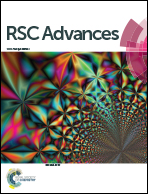Degradation mechanism of a junction-free transparent silver network electrode†
Abstract
In this study, junction-free silver network electrodes with a range of optical transparencies and sheet resistances are developed by using thermal evaporation in the cracked regions of polymer templates that have conformal coatings. In contrast to silver nanowire or carbon nanotube transparent conductive electrodes, there is no contact resistance of the silver mesh electrodes in the silver network, and no post process annealing treatment is required. We focus on investigating the degradation mechanisms of a silver network without junctions under different bias currents. We use CCD-based thermoreflectance microscopy to investigate the temperature variations of the network and locate the hot spots along the different conductive paths. From the distribution of the wasted heat, we notice that the reliability of the network strongly depends on the uniformity and percentage of areal coverage which can be adjusted by different spin-coating speed. A more regular network with an areal coverage of 18% can accommodate 2.6 times the bias current (140 mA) as opposed to that with an areal coverage of only 9% (54 mA) before breaking down. A finite element model is developed to simulate the temperature distribution and predict the breakdown locations of the transparent silver network. Based on the thermoreflectance and scanning electron microscope images of the network under different levels of degradation, we confirm that the primary cause of breakdowns is thermal assisted electromigration in the transparent silver network in this study.


 Please wait while we load your content...
Please wait while we load your content...